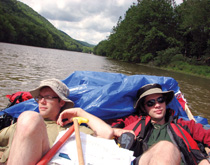Julia Schwarz, Chris Harrison, and Bryan Pendleton were ready to eat the first meal of their three-day summer vacation on the Allegheny River. Lounging on their homemade wooden raft, the three of them—all students in the university's Human Computer Interaction Institute—had just unpacked some tuna sandwiches when the western Pennsylvania sky opened, unleashing a torrential downpour. As they squeezed under the raft's tarp, the lightning started.
"It was right next to us," says Schwarz. "Sometimes it felt as if the thunder came before the lightning. It was ear-splitting." Meanwhile, their raft—a platform of wooden planks, supported by four plastic barrels—had been pushed into a faster current and was hurtling backward toward an overhanging tree branch. If it snagged the raft, the current could push the raft over, knocking them overboard with lightning seemingly everywhere. As Harrison and Pendleton paddled furiously, Schwarz managed to push the branch aside. Throughout the ordeal, Harrison was joking. "I had to laugh to ease the tension," he says.
The voyage was Harrison's idea—to ply the waters of the upper Allegheny beginning in Warren, Pa., in a raft designed to be "a floating platform." Back in the early 1800s, Harrison says the area's lumber trade built wooden rafts that could travel 180 river miles to Pittsburgh where they would be disassembled so the lumber could be sold.
Early on, Harrison convinced Pendleton, another PhD student, to join him for a 35-mile portion of the route, but recruiting another mate was trickier. Harrison says he asked a half-dozen people before Schwarz, a visiting intern, overheard him in the HCII lab. The words "rafting," "building," and "multiday" reeled her in. They spent the next two weeks constructing the raft in Pendleton's garage. The vessel was christened The Joy Willing, in honor of Pendleton's wife, Joy, who gave the trip her consent. After the adventurers borrowed life jackets, tents, and oars from Carnegie Mellon's Explorers Club, preparations were complete.
Apart from the storm, the trip was peaceful, though hardly boring. They constantly had to navigate around islands, rocks, and other obstacles. During quieter moments, they saw turtles, otters, even bald eagles. When it got hot, they swam and checked the raft's underside for damage. At night, they camped on island shores—eating smores, staring at the Milky Way.
On the third day, the crew and The Joy Willing landed safely ashore. They created a Web site www.alleghenyrafters.com, hoping to inspire others to embrace the river.
—Rob Cullen (HS'02)




